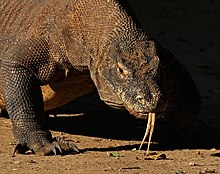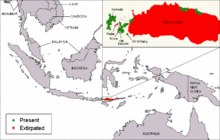
Back Комодо аџьныш Abkhazian Komododraak Afrikaans تنين كومودو Arabic تنين كومودو ARZ Varanus komodoensis AST Komodo varanı Azerbaijani Комодо вараны Bashkir Komodo BAN Komodo BBC Варан камодскі Byelorussian
| Komodo dragon | |
|---|---|

| |
| Komodo National Park, Indonesia | |
| Scientific classification | |
| Domain: | Eukaryota |
| Kingdom: | Animalia |
| Phylum: | Chordata |
| Class: | Reptilia |
| Order: | Squamata |
| Family: | Varanidae |
| Genus: | Varanus |
| Subgenus: | Varanus |
| Species: | V. komodoensis
|
| Binomial name | |
| Varanus komodoensis | |

| |
| Komodo dragon distribution | |
The Komodo dragon (Varanus komodoensis), also known as the Komodo monitor, is a large reptile of the monitor lizard family Varanidae that is endemic to the Indonesian islands of Komodo, Rinca, Flores, Gili Dasami, and Gili Motang. It is the largest extant species of lizard, with the males growing to a maximum length of 3 m (10 ft) and weighing up to 150 kg (330 lb).
As a result of their size, Komodo dragons are apex predators, and dominate the ecosystems in which they live. Komodo dragons hunt and ambush prey including invertebrates, birds, and mammals. Komodo dragons' group behavior in hunting is exceptional in the reptile world. The diet of Komodo dragons mainly consists of Javan rusa (Rusa timorensis), though they also eat considerable amounts of carrion. Komodo dragons also occasionally attack humans.
Mating begins between May and August, and the eggs are laid in September; as many as 20 eggs are deposited at a time in an abandoned megapode nest or in a self-dug nesting hole. The eggs are incubated for seven to eight months, hatching in April, when insects are most plentiful. Young Komodo dragons are vulnerable and dwell in trees to avoid predators, such as cannibalistic adults, which young Komodo dragons also try to repel by rolling in feces. They take 8 to 9 years to mature and are estimated to live up to 30 years.
Komodo dragons were first recorded by Western scientists in 1910. Their large size and fearsome reputation make them popular zoo exhibits. In the wild, their range has been reduced by human encroachment and is likely to contract further from the effects of climate change; hence, they are listed as Endangered by the IUCN Red List. They are protected under Indonesian law, and Komodo National Park was founded in 1980 to aid protection efforts.
- ^ Cite error: The named reference
austwas invoked but never defined (see the help page). - ^ Jessop, Tim; Ariefiandy, Achmad; Azmi, Muhammad; Ciofi, Claudio; Imansyah, Jeri & Purwandana, Deni (2021). "Varanus komodoensis". IUCN Red List of Threatened Species. 2021: e.T22884A123633058. doi:10.2305/IUCN.UK.2021-2.RLTS.T22884A123633058.en. Retrieved 19 November 2021.
- ^ "Appendices". CITES. Retrieved 14 January 2022.
- ^ Ouwens, P. A. (1912). "On a large Varanus species from the island of Komodo". Bulletin de l'Institut Botanique de Buitenzorg. 2. 6: 1–3. Retrieved 6 March 2017.
